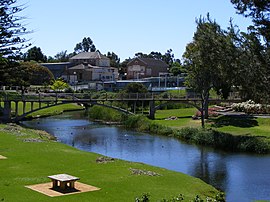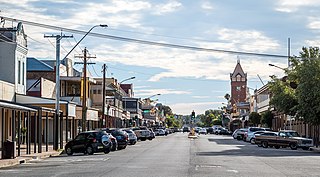
Broken Hill is a city in the far west region of outback New South Wales, Australia. An inland mining city, is near the border with South Australia on the crossing of the Barrier Highway (A32) and the Silver City Highway (B79), in the Barrier Range. It is 315 m (1,033 ft) above sea level, with a hot desert climate, and an average rainfall of 235 mm (9.3 in). The closest major city is Mildura, 300 km (190 mi) to the south and the nearest State Capital City is Adelaide, the capital of South Australia, which is more than 500 km (310 mi) to the southwest and linked via route A32.

Port Pirie is a small city on the east coast of the Spencer Gulf in South Australia, 223 km (139 mi) north of the state capital, Adelaide. Port Pirie is the largest city and the main retail centre of the Mid North region of South Australia. The city has an expansive history which dates back to 1845. Port Pirie was the first proclaimed regional city in South Australia, and is currently the second most important and second busiest port in SA.
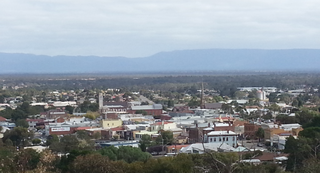
Stawell ( "stall"), is an Australian town in the Wimmera region of Victoria 237 kilometres (147 mi) west-north-west of the state capital, Melbourne. Located within the Shire of Northern Grampians local government area, it is a seat of local government for the shire and its main administrative centre. At the 2021 census, Stawell had a population of 6,220.

Cobar is a town in central western New South Wales, Australia whose economy is based mainly upon base metals and gold mining. The town is 712 km (442 mi) by road northwest of the state capital, Sydney. It is at the crossroads of the Kidman Way and Barrier Highway. The town and the local government area, the Cobar Shire, are on the eastern edge of the outback. At the 2016 census, the town of Cobar had a population of 3,990. The Shire has a population of approximately 4,700 and an area of 44,065 square kilometres (17,014 sq mi).

Mount Barker is a city in South Australia. Located approximately 33 kilometres from the Adelaide city centre, it is home to 21,554 residents (2021). It is the seat of the District Council of Mount Barker, the largest town in the Adelaide Hills, Part of Greater Adelaide, as well as one of the fastest-growing areas in the state.
Australians generally assumed in the 1850s that railways would be built by the private sector. Private companies built railways in the then colonies of Victoria, opened in 1854, and New South Wales, where the company was taken over by the government before completion in 1855, due to bankruptcy. South Australia's railways were government owned from the beginning, including a horse-drawn line opened in 1854 and a steam-powered line opened in 1856. In Victoria, the private railways were soon found not to be financially viable, and existing rail networks and their expansion were taken over by the colony. Government ownership also enabled railways to be built to promote development, even if not apparently viable in strictly financial terms. The railway systems spread from the colonial capitals, except for a few lines that hauled commodities to a rural port.

Truro is a town in South Australia, 80 km northeast of Adelaide. It is situated in an agricultural and pastoral district on the Sturt Highway, east of the Barossa Valley, where the highway crosses somewhat lofty and rugged parts of the Mount Lofty Ranges. At the 2021 census, Truro had a population of 523.

Alexandrina Council is a local government area in the Fleurieu and Kangaroo Island region of South Australia. The Alexandrina Council was formed on 1 July 1997 by the amalgamation of the District Council of Port Elliot and Goolwa, the District Council of Strathalbyn and a portion of the District Council of Willunga. The council is divided into five wards: Nangkita Kuitpo, Angas Bremer, Port Elliot Middleton, Strathalbyn and Goolwa Hindmarsh Island.

The Mount Lofty Ranges are a range of mountains in the Australian state of South Australia which for a small part of its length borders the east of Adelaide. The part of the range in the vicinity of Adelaide is called the Adelaide Hills and defines the eastern border of the Adelaide Plains.
Langhorne Creek is a town in South Australia, located approximately 55 kilometres from the Adelaide city centre. At the 2021 census, Langhorne Creek had a population of 444 residents.

Moonta is a town on the Yorke Peninsula of South Australia, 165 km (103 mi) north-northwest of the state capital of Adelaide. It is one of three towns known as the Copper Coast or "Little Cornwall" for their shared copper mining history.
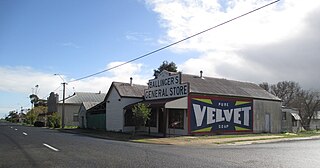
Wolseley is a small South Australian town near the Victorian border. It is five kilometres south of the Dukes Highway and 13 kilometres east of Bordertown. It was first proclaimed a town in 1884.

Beltana is a town 540 kilometres (336 mi) north of Adelaide, South Australia. Beltana is known for continuing to exist long after the reasons for its existence had ceased. The town's history began in the 1870s with the advent of copper mining in the area, construction of the Australian Overland Telegraph Line and The Ghan railway and began to decline in 1941 with the beginning of coal mining at Leigh Creek. The fortune of the town was sealed by the 1983 realignment of the main road away from the town. The town, adjacent cemetery and railway structures are now part of a designated State Heritage Area declared in 1987.
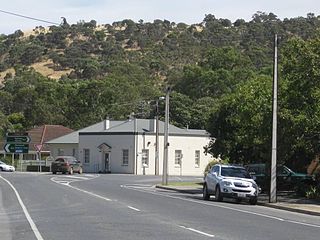
Yankalilla is an agriculturally based town situated on the Fleurieu Peninsula in South Australia, located 72 km south of the state's capital of Adelaide. The town is nestled in the Bungala River valley, overlooked by the southern Mount Lofty Ranges and acts as a service centre for the surrounding agricultural district.
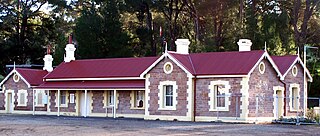
The Victor Harbor railway line is a 1600 mm broad gauge line in South Australia. It originally branched from the Adelaide to Melbourne line at Mount Barker Junction then ran 80.6 kilometres south to Victor Harbor. When the mainline was converted to 1435 mm standard gauge and the junction was closed, the northern end of the Victor Harbor line was curtailed at Mount Barker, 3 kilometres from the junction.

Robert Davenport was a pioneer and politician in the early days of the Colony of South Australia. He was a brother of Sir Samuel Davenport.
Transport in South Australia is provided by a mix of road, rail, sea and air transport. The capital city of Adelaide is the centre to transport in the state. With its population of 1.4 million people, it has the majority of the state's 1.7 million inhabitants. Adelaide has the state's major airport and sea port.

Langhorne Creek wine region is a wine region in South Australia that is located on the plains southeast of the town of Strathalbyn along the lower reaches of the Bremer River and Angas River to Lake Alexandrina. The region received appellation as an Australian Geographical Indication (AGI) in 1998 and as of 2014, has a total planted area of 5,883 ha and is represented by at least 24 wineries.
The Milang railway line was a branch line, now closed, of the former South Australian Railways that left the mainline to Victor Harbor at the farming locality of Sandergrove, 9 km (6 mi) south of Strathalbyn and 89.7 km (55.75 mi) by rail from Adelaide. From there it proceeded in a south-easterly direction for 13.1 km (8.1 mi) to the riverport of Milang on Lake Alexandrina, in the estuary of the River Murray. The line was opened on 17 December 1884; it was formally closed on 17 June 1970. The route is now a "rail trail" that is popular with hikers. The precincts of the former Milang station house a railway museum that includes an innovative locomotive driving simulator for visitors to operate. Onsite is a centre for South Australian historical light railways.
The Bird-in-Hand mine was an underground gold mine near Woodside in the Adelaide Hills east of Adelaide in South Australia. It was the largest of 17 gold mines in the area, and operated between 1881 and 1889. It produced 10,500 ounces (300,000 g) of gold at an average grade of 12.9 grams per tonne in the 1880s. The mine closed when the inflow of water made it uneconomic to continue, and miners moved to Broken Hill where rich ore had been found.
